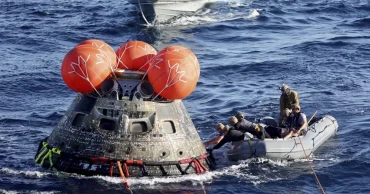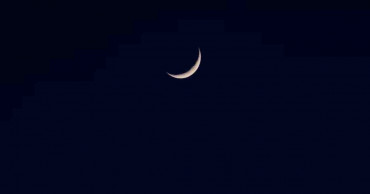moon
Is the moon shrinking? Here’s what scientists say
New research suggests that the moon’s South Pole, a hotspot for future exploration, might be more challenging than expected due to “moonquakes” and landslides.
The moon's allure as a target for space agencies like NASA and private companies like SpaceX is undeniable. But a recent study funded by NASA throws a cautionary flag on the lunar South Pole, a region rich in potential water ice and the target for several upcoming missions, reports CNN.
The study revealed that the moon’s core is cooling and shrinking, causing its surface to wrinkle and crack, similar to a raisin, it said.
China sends its youngest-ever crew to space as it seeks to put astronauts on moon before 2030
These “faults” trigger moonquakes lasting for hours and landslides, potentially posing a threat to future human settlements and equipment.
The moon may seem geologically dead, but its interior is still hot, making it seismically active. The study links a powerful moonquake detected by Apollo astronauts to faults near the South Pole, highlighting the potential dangers.
While the findings won’t affect the upcoming Artemis III mission due to its short duration, they raise concerns for long-term lunar settlements. Future site selection may consider factors like proximity to tectonic features.
India becomes the fourth country to successfully land a spacecraft on the moon
Yosio Nakamura, , a professor emeritus of geophysics at the University of Texas at Austin, who was among the researchers who first looked at the data collected by the Apollo seismic stations, disagreed with the study’s cause of shallow moonquakes, suggesting they originate deeper within the moon. He emphasized the need for more data.
Allen Husker, a research professor of geophysics at the California Institute of Technology, said “It is very unlikely that a large moonquake will happen while they are there. However, it is good to know that these seismic sources (causing the quakes) exist. They can be an opportunity to better study the moon as we do on the earth with earthquakes,” Husker said. “By the time there is an actual moon base, we should have a much better idea of the actual seismic hazard with upcoming missions.”
Jeffrey Andrews, an associate professor of planetary science at the University of Arizona, said, “Moonquakes are an incredible tool for doing science.” “They are like flashlights in the lunar interior that illuminate its structure for us to see. Studying moonquakes at the South Pole will tell us more about the moon’s interior structure as well as its present-day activity,” he added.
Japan becomes the fifth country to land a spacecraft on the moon
1 year ago
India launches spacecraft to study the sun after successful landing near the moon's south pole
India launched its first space mission to study the sun on Saturday, less than two weeks after a successful uncrewed landing near the south polar region of the moon.
The Aditya-L1 spacecraft took off on board a satellite launch vehicle from the Sriharikota space center in southern India on a quest to study the sun from a point about 1.5 million kilometers (930,000 miles) from earth.
Read : Chandrayaan-3 a glowing testament to what India can achieve with passion: Indian Cabinet
The spacecraft is equipped with seven payloads to study the sun's corona, chromosphere, photosphere and solar wind, the Indian Space Research Organization said.
India became the first country to land a spacecraft near the moon's south pole on Aug. 23 — a historic voyage to uncharted territory that scientists believe could hold vital reserves of frozen water. After a failed attempt to land on the moon in 2019, India joined the United States, the Soviet Union and China as only the fourth country to achieve this milestone.
The sun study, combined with India's successful moon landing, would completely change the image of ISRO in the world community, said Manish Purohit, a former ISRO scientist.
Read : Pakistan vs India 1st ODI in Asia Cup 2023: Match Preview
The Aditya-L1 was headed for the L1 point of the Earth-Sun system, which affords an uninterrupted view of the sun, ISRO said. "This will provide a greater advantage of observing solar activities and their effect on space weather in real-time."
Once in place, the satellite would provide reliable forewarning of an onslaught of particles and radiation from heightened solar activity that has the potential to knock out power grids on Earth, said B.R. Guruprasad, a space scientist, in an article in The Times of India newspaper. The advanced warning can protect the satellites that are the backbone of global economic structure as well as the people living in space stations.
Read : Bangladesh’s development, growing capabilities stood to add value to G20 discussions: India
"Those seven payloads are going to study the sun as a star in all the possible spectrum positions that we have visible, ultraviolet, and X-ray. … It's like we're going to get a black and white image, the color image and the high-definition image, 4K image of the sun, so that we don't miss out on anything that is happening on the sun," Purohit said.
2 years ago
ISRO Chandrayaan-3: 9 Women Scientists Who Led India’s Moon Landing
Roles assumed by women have undergone a profound evolution. Transitioning from traditional nurturing responsibilities, they have emerged as indispensable contributors across diverse domains, including science and technology. Chandrayaan-3 hailed the women scientists who led India’s moon landing. This article serves as a tribute to the female engineers who orchestrated the expedition, making groundbreaking history.
Groundbreaking Chandrayaan-3 mission
ISRO, or the Indian Space Research Organisation, is India's national space agency. Chandrayaan-3 marks the third chapter in its lunar exploration saga through the Chandrayaan program. Its purpose is to explore the moon's surface, study lunar composition, and demonstrate soft landing capabilities.
Embarking on a transformative lunar exploration journey, Chandrayaan-3 stands as a testament to India's space ambitions. Launched on July 14, 2023, from Sriharikota, Andhra Pradesh, this mission is an extension of ISRO's lunar program, aiming to explore the moon's mysteries with precision.
Read more: 3 Bangladeshi women make it to list of top 100 Asian scientists
The mission comprises the Vikram lander and the Pragyan rover, symbolising technological innovation. The propulsion module facilitated the lunar orbit insertion, a crucial step, achieved on August 5, 2023. This propelled the spacecraft into an orbit around the moon, preparing for a historic lunar landing.
Vikram, equipped with four landing legs and thrusters, carries both Pragyan and scientific instruments for lunar analysis. Pragyan, the six-wheeled rover, embarked on an odyssey across the lunar surface.
Chandrayaan-3's triumphant lunar descent on August 23, 2023 showcased India's prowess in soft landings. With meticulous calculations, Vikram achieved a controlled touchdown, setting the stage for Pragyan's mission.
Read more: New crew for the space station launches with 4 astronauts from 4 countries
Pioneering Women Scientists behind Chandrayaan-3 Mission
Within Chandrayaan-3's celestial voyage, a constellation of remarkable women scientists emerges. This assembly of 54 adept female engineers and scientists exemplifies the culmination of scientific excellence intertwined with relentless determination. Here are the nine leading women scientists who were part of India’s Chandrayaan-3 lunar mission.
Ritu Karidhal Srivastava
This accomplished Indian scientist and aerospace engineer started on her ISRO journey in 1997. As the Deputy Operations Director of India's Mars Orbiter Mission (Mangalyaan), she played a pivotal role in orchestrating the spacecraft's autonomy system. It enables the spaceship to navigate space autonomously and respond to anomalies with precision.
Fondly referred to as one of India's "Rocket Women," Ritu's contributions were undeniable in propelling India into the exclusive league of space explorers. Her expertise resonates in conceptualizing and executing the craft's onward autonomy system. It was a cornerstone of the mission's success.
Read more: 10 Greatest Female Scientists of All Time
Kalpana Kalahasti
Kalpana, armed with an aeronautical engineering degree from Indian Institute of Technology Kharagpur, entered ISRO in 2003 as a scientist. Her illustrious career includes diverse satellite projects, including communication and remote sensing satellites. This expertise has transformed India's capabilities in data collection and communication.
The significant milestones of her career include Mars Orbiter Mission and Chandrayaan-2. Her ingenious design of propulsion systems and imaging equipment exemplified her engineering prowess. Notably, her integral role in the Chandrayaan-2 and Mangalyaan missions underscores her versatility and indelible contributions.
Dr. V. R. Lalithambika
Dr. V. R. Lalithambika, a stalwart since 1988, carved her niche in the realm of Advanced Launcher Technologies. Her journey with ISRO commenced at the Vikram Sarabhai Space Centre (VSSC), where she joined as a young engineer. Over the years, she led a team that designed rocket control and guidance systems, an integral aspect of mission success. Her expertise spans over a hundred space missions, reflecting her adeptness in engineering and leadership.
Read more: Jute Sanitary Napkins: Bangladeshi scientist Farhana Sultana got awarded for eco-friendly innovation
2 years ago
NASA Orion capsule safely blazes back from moon, aces test
NASA’s Orion capsule made a blisteringly fast return from the moon Sunday, parachuting into the Pacific off Mexico to conclude a test flight that should clear the way for astronauts on the next lunar flyby.
The incoming capsule hit the atmosphere at Mach 32, or 32 times the speed of sound, and endured reentry temperatures of 5,000 degrees Fahrenheit (2,760 degrees Celsius) before splashing down west of Baja California near Guadalupe Island. A Navy ship quickly moved in to recover the spacecraft and its silent occupants — three test dummies rigged with vibration sensors and radiation monitors.
NASA hailed the descent and splashdown as close to perfect, as congratulations poured in from Washington..
“I'm overwhelmed,” NASA Administrator Bill Nelson said from Mission Control in Houston. “This is an extraordinary day ... It's historic because we are now going back into space — deep space — with a new generation.”
Read more: NASA's Orion capsule reaches moon, last big step before lunar orbit
The space agency needed a successful splashdown to stay on track for the next Orion flight around the moon, targeted for 2024 with four astronauts who will be revealed early next year. That would be followed by a two-person lunar landing as early as 2025 and, ultimately, a sustainable moon base. The long-term plan would be to launch a Mars expedition by the late 2030s.
Astronauts last landed on the moon 50 years ago. After touching down on Dec. 11, 1972, Apollo 17′s Eugene Cernan and Harrison Schmitt spent three days exploring the valley of Taurus-Littrow, the longest stay of the Apollo era. They were the last of the 12 moonwalkers.
Orion was the first capsule to visit the moon since then, launching on NASA’s new mega moon rocket from Kennedy Space Center on Nov. 16. It was the first flight of NASA’s new Artemis moon program, named after Apollo’s mythological twin sister.
“From Tranquility Base to Taurus-Littrow to the tranquil waters of the Pacific, the latest chapter of NASA’s journey to the moon comes to a close. Orion back on Earth,” announced Mission Control commentator Rob Navias.
While no one was on the $4 billion test flight, NASA managers were thrilled to pull off the dress rehearsal, especially after so many years of flight delays and busted budgets. Fuel leaks and hurricanes conspired for additional postponements in late summer and fall.
In an Apollo throwback, NASA held a splashdown party at Houston’s Johnson Space Center on Sunday, with employees and their families gathering to watch the broadcast of Orion’s homecoming. Next door, the visitor center threw a bash for the public.
Getting Orion back intact after the 25-day flight was NASA’s top objective. With a return speed of 25,000 mph (40,000 kph) — considerably faster than coming in from low-Earth orbit — the capsule used a new, advanced heat shield never tested before in spaceflight. To reduce the gravity or G loads, it dipped into the atmosphere and briefly skipped out, also helping to pinpoint the splashdown area.
Read more: NASA’s newest moon rocket lifts off 50 years after Apollo
All that unfolded in spectacular fashion, officials noted, allowing for Orion’s safe return.
“I don't think any one of us could have imagined a mission this successful," said mission manager Mike Sarafin.
Further inspections will be conducted once Orion is back at Kennedy by month’s end. If the capsule checks find nothing amiss, NASA will announce the first lunar crew amid considerable hoopla in early 2023, picking from among the 42 active U.S. astronauts stationed at Houston’s Johnson Space Center.
“People are anxious, we know that,” Vanessa Wyche, Johnson's director, told reporters. Added Nelson: “The American people, just like (with) the original seven astronauts in the Mercury days, are going to want to know about these astronauts.”
The capsule splashed down more than 300 miles (482 kilometers) south of the original target zone. Forecasts calling for choppy seas and high wind off the Southern California coast prompted NASA to switch the location.
Orion logged 1.4 million miles (2.25 million kilometers) as it zoomed to the moon and then entered a wide, swooping orbit for nearly a week before heading home.
It came within 80 miles (130 kilometers) of the moon twice. At its farthest, the capsule was more than 268,000 miles (430,000 kilometers) from Earth.
Orion beamed back stunning photos of not only the gray, pitted moon, but also the home planet. As a parting shot, the capsule revealed a crescent Earth — Earthrise — that left the mission team speechless.
Nottingham Trent University astronomer Daniel Brown said the flight's many accomplishments illustrate NASA's capability to put astronauts on the next Artemis moonshot.
“This was the nail-biting end of an amazing and important journey for NASA’s Orion spacecraft," Brown said in a statement from England.
The moon has never been hotter. Just hours earlier Sunday, a spacecraft rocketed toward the moon from Cape Canaveral. The lunar lander belongs to ispace, a Tokyo company intent on developing an economy up there. Two U.S. companies, meanwhile, have lunar landers launching early next year.
3 years ago
Crescent moon sighted; Saudi Arabia to celebrate Eid-ul-Azha on July 9
Saudi Arabia will celebrate Eid-ul-Azha, the feast of the sacrifice, on July 9, as the crescent moon of Zilhajj was sighted Wednesday.
The sighting of the crescent moon of Zilhajj, the month in which the hajj pilgrimage takes place, was confirmed at the Tamir Observatory, near Riyadh, in the evening, according to the Saudi Supreme Court.
So, Thursday will be the first day of Zilhajj, the twelfth and final month of the Islamic calendar.
The first day of Eid-ul-Azha, the second-largest religious festival for Muslims, will be on July 9 in most Arab and Muslim countries while many Southeast and South Asian countries will start the celebrations on July 10.
Usually, the crescent of Zilhajj is first sighted in Saudi Arabia and then a day later in Bangladesh, Pakistan, and some other countries.
Today, Pakistan, Malaysia, Indonesia, Japan, Hong Kong and Brunei announced July 10 as the first day of Eid-ul-Azha.
The religious festival marks the end of hajj and commemorates Prophet Ibrahim's willingness to sacrifice his son Ismail on Allah's will.
Prophet Ibrahim was eventually given a lamb to sacrifice. So, Muslims perpetuate the tradition by slaughtering a lamb or a cow and sharing the meat with people in need.
This year's hajj will start on July 6 and Eid-ul-Azha will be three days later in Saudi Arabia.
Muslims around the world celebrate Eid-ul-Azha almost the same way with the morning being marked with Eid prayers and the slaughtering of sacrificial animals. The celebration last for three days.
Also read: 2,415 more Bangladeshis can perform Hajj this year
3 years ago
National Moon sighting committee to sit Saturday
The National Moon Sighting Committee will sit on Saturday to ascertain the commencement of holy Ramadan, the lunar month of self-purification through fasting and abstinence.
The meeting will be held in the conference room of the Islamic Foundation's Baitul Mukarram office in the capital around 6:30 pm after Maghrib prayers.
READ: National Moon sighting committee to sit Tuesday
State Minister for Religious Affairs Faridul Haque will preside over the meeting.
People, if they see the moon anywhere in the country, have been requested to inform the committee by dialing telephone numbers 02-223381725, 02-41050912, 02-41050916, and 02-41050917 or faxing – 02-223383397 and 02-9555951.
3 years ago
Toyota heading to moon with cruiser, robotic arms, dreams
Toyota is working with Japan’s space agency on a vehicle to explore the lunar surface, with ambitions to help people live on the moon by 2040 and then go live on Mars, company officials said Friday.
The vehicle being developed with the Japan Aerospace Exploration Agency is called Lunar Cruiser, whose name pays homage to the Toyota Land Cruiser sport utility vehicle. Its launch is set for the late 2020’s.
The vehicle is based on the idea that people eat, work, sleep and communicate with others safely in cars, and the same can be done in outer space, said Takao Sato, who heads the Lunar Cruiser project at Toyota Motor Corp.
“We see space as an area for our once-in-a-century transformation. By going to space, we may be able to develop telecommunications and other technology that will prove valuable to human life,” Sato told The Associated Press.
READ: Khulna man buys land on moon for wife
Gitai Japan Inc., a venture contracted with Toyota, has developed a robotic arm for the Lunar Cruiser, designed to perform tasks such as inspection and maintenance. Its “grapple fixture” allows the arm’s end to be changed so it can work like different tools, scooping, lifting and sweeping.
Gitai Chief Executive Sho Nakanose said he felt the challenge of blasting off into space has basically been met but working in space entails big costs and hazards for astronauts. That’s where robots would come in handy, he said.
Since its founding in the 1930s, Toyota has fretted about losing a core business because of changing times. It has ventured into housing, boats, jets and robots. Its net-connected sustainable living quarters near Mount Fuji, called Woven City, where construction is starting this year.
Japanese fascination with the moon has been growing.
A private Japanese venture called ispace Inc. is working on lunar rovers, landing and orbiting, and is scheduled for a moon landing later this year. Businessman Yusaku Maezawa, who recently took videos of himself floating around in the International Space Station, has booked an orbit around the moon aboard Tesla CEO Elon Musk’s Starship.
Toyota engineer Shinichiro Noda said he is excited about the lunar project, an extension of the automaker’s longtime mission to serve customers and the moon may provide valuable resources for life on Earth.
READ: Japan aims to bring back soil samples from Mars moon by 2029
“Sending our cars to the moon is our mission,” he said. Toyota has vehicles almost everywhere. “But this is about taking our cars to somewhere we have never been.”
3 years ago
Khulna man buys land on moon for wife
A Khulna man has bought an acre of land on the moon as a token of love for his wife on their sixth wedding anniversary.
MD Ashim, a resident of Modern Mor area in Khulna city, handed over the land deeds to his wife Israt Tupma on Thursday.
Md Ashim, divisional head of a private TV channel, told UNB he fulfilled his dream of gifting something very special today inspired by a man in India, who also bought land on the moon for wife for their anniversary.
On September 20, Ashim bought the land worth $45 from a US agency named ‘Lunar Embassy’ owned by a man named Dennis Hop.
Ashim said after buying the land he received a selling agreement, a satellite photo of the land, geographical position of the land and legal documents from the agency.
Israt Tumpa said she feels as if she literally has got the moon in her hands as a surprise gift.
Lunar Embassy is the most famous company known for selling land on the moon. According to the company per acre of land costs $24.99 to $499.
4 years ago
Eid-ul-Azha: Moon Sighting Committee to meet Sunday
A meeting of the National Moon Sighting Committee will be held on Sunday to fix the date of Eid-ul-Azha, the second largest religious festival of Muslims.
The meeting will be held in the office of the Islamic Foundation at Baitul Mukarram at 7:15pm with State Minister for Religious Affairs Mohammad Faridul Haque Khan in the chair, said an Islamic Foundation media release on Saturday.
The committee will announce the date of Eid-ul-Azha after reviewing information about the sighting of Zilhaj moon.
Also read: National Moon Sighting Committee to meet Wednesday evening
People have been requested to inform the committee over the following phone and fax numbers if they see the Zilhaj moon anywhere in Bangladesh sky.
Also read: National Moon sighting committee to sit Tuesday
The telephone numbers are: 9559493, 9555947, 9556407 and 9558337, while the fax numbers are 9563397 and 9555951.
Also read: National Moon Sighting Committee to sit Tuesday
4 years ago
China prepares for return of lunar probe with moon samples
Chinese ground crews are standing by for the return of a lunar probe bringing back the first fresh samples of rock and debris from the moon in more than 45 years.
5 years ago






.jpg)
.jpg)








